Dart clears hurdles as compelling compact
By John Gilbert
AUSTIN, TEXAS — Chrysler’s new-car stable was so desperate for a compact car that the bar was pretty low for the 2013 Dodge Dart to hurdle. For example, imagine that to be successful you only had to pick two of the following assets: A. good looks, outside and inside; B. tight build quality; C. excellent fuel economy; D. reasonable base price; E. performance that is pleasingly peppy; F. precise and agile ride and handling; G. genuine high-technology features; and H. contemporary connectivity standards.While picking only two, be aware that there are a number of successful cars out there without more than a couple of those assets. When the 2013 Dodge Dart makes its way into showrooms by June of 2012, however, the Dart listing will need one more choice, for “all of the above.” The Dart seems to have it all, after a brief preliminary test of preproduction models, starting with the first-glance attractiveness that makes it such a bonus to have Italian flair mingling with Chrysler engineering.
All of that, and the rest of the endless array of features, would fall flat, however, without the allure of initial pricing, in order to compete with the likes of Honda Civic, Ford Focus, Mazda 3, Chevrolet Cruze, Toyota Corolla, Nissan Sentra, and Hyundai Elantra. The Dart gobbles up that objective, too.
Five different Dart models expand from there with assorted technical and package options. They include:
- SE, with all the good looks standard 2.0-liter engine, four-wheel disc brakes, brake assist, brake-lock differential, stability control with electronic roll mitigation, traction control, plus 10 airbags, at $16,790.
- SXT, which adds extra content such as power mirrors, taillight surround, heavy-duty battery, console, 17-inch wheels, and makes a turbo engine available, for $18,790.
- Rallye, adding foglights, trip computer, steering wheel remote controls, and leather-wrapped steering wheel, at $19,790.
- Limited adds a U-Connect 8.4-inch touchscreen with voice-command multimedia, numerous power options including a nine-speaker audio upgrade, sunroof, active grille shutters and underbody panels to enhance the drag coefficient to a scant 0.285, at $20,790.
- R/T, with all the Limited goodies plus a 184-horsepower 2.4-liter engine, special leather seats, sport suspension and various performance trim features, for $23,290.
The performance-oriented R/T won’t be available until a few months after the rest of the Dart fleet reaches showrooms. But one of the dizzying features about the Dart is that it will be available for custom-ordering and rapid-delivery, two things which might seem mutually exclusive. It’s all in the plan for allowing customers to select a Dart with exactly the equipment an individual might want. Everything above the basic SE gets the “racetrack” taillights, which are featured on the Charger and encircle the whole rear facade with a row of 152 LED lights.
Among the major challenges facing Chrysler Corporation two years ago was that consumers reacted to the plunging economy by scrambling to buy smaller and more fuel-efficient cars, and there were no — as in zero — compact or subcompact vehicles anywhere to be found in the entire Dodge-Chrysler inventory. The Neon had been OK, but disappeared in favor of the Caliber, which was precisely between small SUV and tall station wagon in a netherworld that left it out of either category.
Fiat’s buyout came along just about then, saving the company from potential extinction. Immediate renovation of the interiors and feature trim on all existing Dodge and Chrysler vehicles was impressive, but there was still the major vacancy — no compact car in an ever-more-compact world. Fiat wanted to come back into the U.S. market with its own Fiat 500 subcompact, as a separate entity, and that has happened. Meanwhile, Dodge and Chrysler had decided to discontinue the Caliber two years ago, and when Fiat installed Sergio Marchione as new Chrysler CEO, the idea of a new compact car was hot on the griddle. In November of 2010, the decision was made — Go!
Remarkably, the whole Dart project came together in 18 months, which normally might be the time of initial drawings and discussions. The brief time from concept to rollout might imply that a lot of shortcuts were taken, and shortcuts often lead to trouble in the car world. But preliminary examination and driving of preproduction Darts on the roadways of West Texas indicate the Dart looks good, and it operates better than it looks.
The Dodge stand at all the big U.S. auto shows has been a popular place, thanks to the Dart. The Dart would have deserved notice as the most compelling vehicle displayed if it hadn’t been for the splash made by the upcoming Ford Fusion. As it is, there seems no doubt that the Dart, with its dashing (Darting?) good looks, could challenge the Fusion at Car-of-the-Year voting time. It has a low, sleek look to it, with its four-door body stretched tight from covering its spacious trunk, tracing forward over a smooth roofline, and dropping down over the hood to a low and fashionable grille. The familiar Dodge “cross-hairs” grille has been modified to be very narrow in height and very wide horizontally, from headlight to headlight. The look changes by model and personal choice, too, with color-keyed, or chrome, or blacked-out background to give different Darts different personalities.
The body looks good enough to stand on its own, but what’s under the skin is even more impressive. Fiat now only builds good small cars in Italy, it also owns a few world-class marques, such as Ferrari, Alfa Romeo, and Lancia. When the Alfa Giulietta compact sedan hit the streets of Europe, it was an immediate success. When Mercedes owned Chrysler, there was always a feeling that it was treating its American conquest as a stepchild; with Fiat, there is a definite feeling that the Italians are honored to have the chance to mix, match and blend with Chrysler models. The Chrysler 300, for example, was brought to Italy to serve as the halo model Lancia. So with a snap of Fiat fingers, Chrysler engineers found themselves free to experiment with the well-formed Giulietta platform. It has proven to be so strong that it will serve in various sizes to underpin virtually all Dodge and Chrysler sedans moving forward. But first, the Dart.
Dodge engineers lengthened the platform 12 inches, and widened the Giulietta architecture by 2 inches to create a compact car that cheats. The expanded size creates more interior room than other compacts, and indeed meets EPA standards for midsize cars. The rigidity of the platform benefits from a body consisting of 68 percent high-strength steel, and 600 hours of wind-tunnel development on the aerodynamics of every shape including the underside, lends itself well to the latest sound-deadening techniques, resulting in a refined and quiet demeanor.
A stretched Italian platform under a made-in-America (Belvidere, Ill.) sedan indicates how global the Dart is, and examining the intriguing array of engines and transmissions adds new evidence to the true global concoction. Chrysler and Mitsubishi joined Hyundai in search of a high-tech global four-cylinder engine a few years ago, and the timing was perfect, because Hyundai had just connected all the dots on its breakthrough technology to produce the 2.4-liter engine for all three to use. Next, Hyundai designed and built its own six-speed automatic transmission that is world-class in efficiency and size. Meanwhile, in Italy, Fiat was experimenting with its MultiAir system, which eliminates the intake camshaft and uses oil-pressure tubes from the exhaust valves to actuate the intake valves. It is a brilliant technology that allows almost infinite valve-timing advances or delays for improved power and fuel-efficiency, and it is what makes the little Fiat 500 go. A turbocharged version of that 1.4-liter engine makes the Fiat Abarth REALLY go. In 2009, the engine started finding its way into other Alfa models.
So here comes Chrysler, ready, willing and able to capitalize on all that technology coming from all corners of the globe. The leadoff hitter in the Dart lineup is the 2.0 Tigershark engine, with dual overhead camshafts, dual counter-rotating balance shafts, reduced noise, vibration and harshness. Since being born on Hyundai schematics, the engine consists of 88 percent new parts, and — with 160 horsepower and 148 foot-pounds of torque — will be the standard engine in all Darts except the R/T. Fuel estimates are 25 city and 36 highway with the Fiat-sourced 6-speed manual transmission.
Next up is the 1.4-liter MultiAir Turbo 4-cylinder, which is optional on all models except the R/T, and it gains surprising power from its Honeywell turbocharger, which spins at 220,000 RPMs to urge 160 horsepower and 184 foot-pounds of torque out of those 1.4 liters. It will be the mileage king of the Darts, with EPA estimates of 27 city and 39 mpg in highway driving, with the 6-speed stick, right out of the Fiat Abarth.
The engine still to be tested is the 2.4-liter Tigershark, which powers the R/T and is extremely intriguing because it takes the basically Hyundai-sourced engine from South Korea, and the MultiAir technology from Italy, and builds the engine in Dundee, Michigan. The refined finished product is called “MultiAir 2” for increased fuel efficiency and midrange torque, and decreased noise and harshness. A forged steel crankshaft with cast aluminum pistons designed specifically for the revised MultiAir system should keep the fuel economy up near 30 while producing 184 horsepower and 171 foot-pounds of torque. Because of the MultiAir 2 operation, the peak horsepower will be available from 2,500-4,000 RPMs, and the peak torque starts at 2,600 RPMs and stays there until 4,100 revs.
An area of extreme importance to optimum fuel economy is the blending of high-tech engines with equally high-tech transmissions. In the Dart’s case, three transmissions are available and all three are 6-speeds, while some prominent segment players still languish with 5. First is the smooth-as-silk 6-speed stick, which comes from Fiat. Second is a 6-speed automatic, brought in from Hyundai. And still to come is a 6-speed dual-dry-clutch from Fiat.
From brief drives, the Abarth’s MultiAir turbo offers a sporty alternative to the daily driving chores, while the 2.0-liter 4-cylinder Dart will undoubtedly be the biggest seller, handling normal duties with ease and still offering the eye-catching looks of the new Dart.
Comments
Tell me what you're thinking...
and oh, if you want a pic to show with your comment, go get a gravatar!


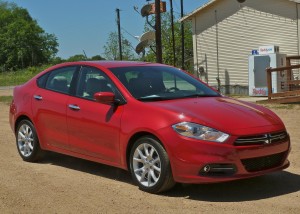
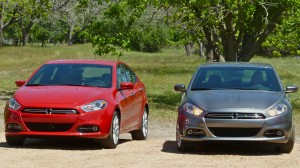
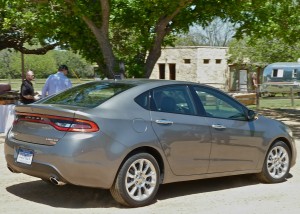
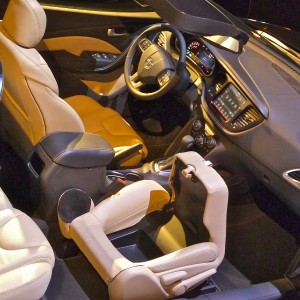
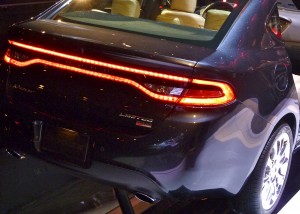
 John Gilbert is a lifetime Minnesotan and career journalist, specializing in cars and sports during and since spending 30 years at the Minneapolis Tribune, now the Star Tribune. More recently, he has continued translating the high-tech world of autos and sharing his passionate insights as a freelance writer/photographer/broadcaster. A member of the prestigious North American Car and Truck of the Year jury since 1993. John can be heard Monday-Friday from 9-11am on 610 KDAL(www.kdal610.com) on the "John Gilbert Show," and writes a column in the Duluth Reader.
John Gilbert is a lifetime Minnesotan and career journalist, specializing in cars and sports during and since spending 30 years at the Minneapolis Tribune, now the Star Tribune. More recently, he has continued translating the high-tech world of autos and sharing his passionate insights as a freelance writer/photographer/broadcaster. A member of the prestigious North American Car and Truck of the Year jury since 1993. John can be heard Monday-Friday from 9-11am on 610 KDAL(www.kdal610.com) on the "John Gilbert Show," and writes a column in the Duluth Reader.